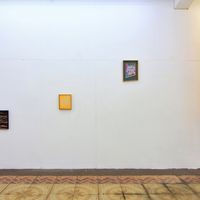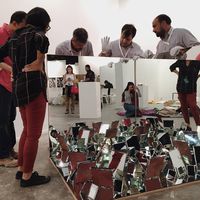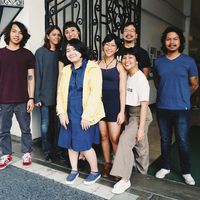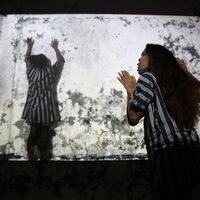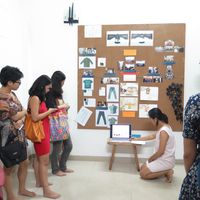The ebbs and flows of creative spaces in Metro Manila
 Urban space in Metro Manila is a timely topic of discussion these days. With a population of 20 million and rising, the city and surrounding municipalities like Quezon City and Makati are faced with overcrowding, informal settlements, a construction boom, and decades of bad urban planning. The result is a steady decline in green spaces and spots dedicated to leisure. It is no wonder, then, that varied initiatives have popped up over the years to use space in different ways. This article hopes to have an initial overview of recently established creative spaces promoting contemporary art in Metro Manila, and to explore the issues and trends surrounding them.
Urban space in Metro Manila is a timely topic of discussion these days. With a population of 20 million and rising, the city and surrounding municipalities like Quezon City and Makati are faced with overcrowding, informal settlements, a construction boom, and decades of bad urban planning. The result is a steady decline in green spaces and spots dedicated to leisure. It is no wonder, then, that varied initiatives have popped up over the years to use space in different ways. This article hopes to have an initial overview of recently established creative spaces promoting contemporary art in Metro Manila, and to explore the issues and trends surrounding them.‘Creative space’ is a general term to refer to places where creative production, such as exhibitions, performances, rehearsals, and events, take place. They are usually physical spaces with multipurpose functions. They may be constructed with a long-term programme in mind, but can also be empty lots used only for specific occasions. In some cases, these spaces hold great symbolic value in communities. The idea of a ‘creative space’ emerged as a result of campaigns like the ‘creative city’ and UNESCO’s ‘creative and cultural industries’ (CCIs). This article would like to explore the more recent organisations promoting contemporary art in or just outside Metro Manila. Following related studies, such as Lena COBANGBANG’s Parallel Platforms: Mapping the Past, Present, Future in 2008, this text hopes to expand the discussion on creative spaces, examine how they sustain themselves, and detect related issues and trends.
In the Philippines, many terms could be synonymous to ‘creative space’, such as: ‘independent space’, ‘artist-run space’, ‘alternative space,’ or the more used ‘art space’, ‘gallery’, ‘atelier’, and ‘museum’. Their points of departure seem to be hinged upon whether these spaces are non-profit, commercially-based, or symbolic; their meaning, and how they reflect a city and its creativity.
It has been almost two decades since non-profit, artist-run spaces like Surrounded by Water, Big Sky Mind, and Green Papaya Art Projects were established in Metro Manila. These spaces were created from a need to provide venues for exhibition and experimentation for young artists. Peewee ROLDAN, founder of Green Papaya Art Projects explains, "There has never been enough cultural infrastructure and support from the government. So artists determined to practice and operate outside the mainstream gallery system are inclined to run their own spaces. The operative word today is ‘independent’ rather than ‘alternative.’ Seminal spaces like Surrounded by Water and Big Sky Mind have ceased to exist due to different factors like lack of funds, and artists maturing and looking for a more stable practice."
Apart from those independent artist-run spaces, many other creative clusters in the city have sprung up, notably, the Artwalk at Megamall, from the 1990s to the early 2000 – literally a mega mall – where most of the galleries in the city were situated. The transformation of Pasong Tamo Extension (now Don Chino Roces Avenue) in the business district of Makati flourished from an area mostly inhabited by car garage shops to a creative avenue of galleries, furniture shops, and advertising agencies, led by Silverlens Galleries in 2006. Cubao Expo in Quezon City, originally a show window cum store for shoemakers from Marikina, attracted a young community of artists and business owners to open shop, thanks to low rental rates. Sadly, after a series of rental increases, many of these original shops closed down or moved elsewhere, save for some like Pablo Gallery, which evolved into a retail art store called Post.
Emerging models
Nowadays, there seems to be a trend of hybrid spaces that engage in multidisciplinary activities. 98B COLLABoratory in old Manila, for example, which started in 2012, is an artist-run independent space with a screening room, exhibition space, kitchen, small library, and retail space. According to co-founder Mark SALVATUS, 98B COLLABoratory is a response “to the need (for) a place for young artists to show their works in a non-white cube setting, creating site-specific works in empty spaces in Escolta street wherein we have a good relationship with the building owners.”
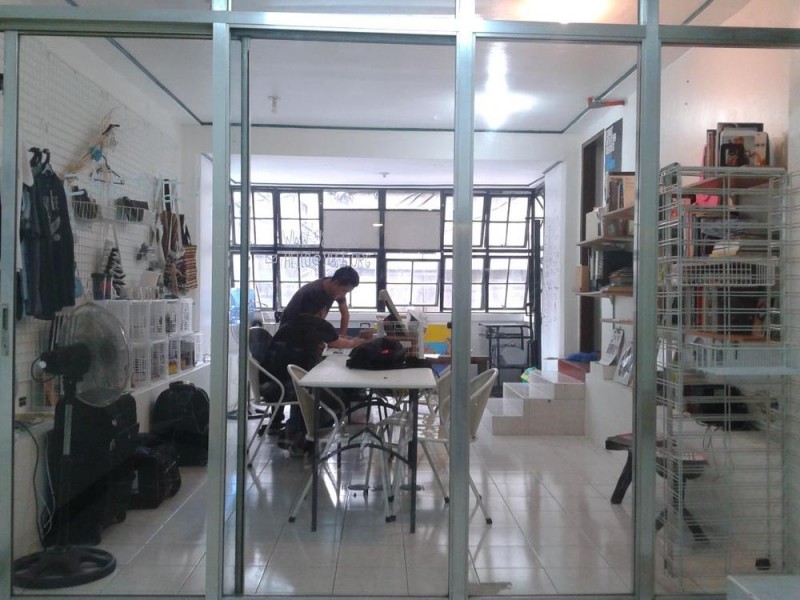 98B COLLABoratory in old Manila. Photo courtesy of Mark SALVATUS.
98B COLLABoratory in old Manila. Photo courtesy of Mark SALVATUS.
Another model concerned with creative spaces is Viva Manila, a non-profit organisation. While not a physical space, Viva Manila is a promoter of urban space, particularly that of old Manila. Through events and other programmes, Viva Manila’s team members “seek to increase the liveability and creativity of the neighbourhoods in Manila by building partnerships, respecting the city’s heritage, supporting local businesses, advocating for public space, activating under-utilised spaces, (and) promoting walking and biking in the city.” The group is led by artists, urban planners, and cultural workers.
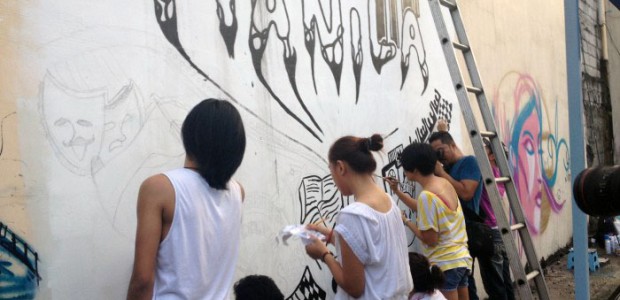 Mural-making in 2014 during one of Viva Manila’s flagship project, The Intramuros Pasyal Project. Photo courtesy of Viva Manila.
Mural-making in 2014 during one of Viva Manila’s flagship project, The Intramuros Pasyal Project. Photo courtesy of Viva Manila.
Perhaps due to Metro Manila’s generally high rent, lack of space options, or the creative scene being metro-centric, another observable trend is the emergence of organisations outside the city. An initiative 100 kilometres south of Manila is Filipino artist Leslie de CHAVEZ’ Project Space Pilipinas (PSP). Located in de Chavez’ rural hometown of Quezon Province, PSP is an artist-run platform that offers residencies to artists from all over the world. Depending on its activities, PSP’s space can be a living quarter, gallery, or meeting place. A recent project in May 2015 saw the space as an exhibition of site-specific works all over town as a way of introducing contemporary art to the community.
Pinto Art Museum, founded by long-time art patron Dr. Joven CUANANG, is a bigger establishment situated in the hills of Antipolo, 25 kilometres off Manila. The one-hectare museum serves as an exhibition space of Dr. Cuanang’s collection of contemporary and indigenous Filipino art. Within the property, there are several galleries, a public garden, restaurant, and an art gallery. The space has earned a reputation as a cultural destination worth visiting since it opened in 2010.
 One of the many galleries at the Pinto Art Museum. Photo by Lai del ROSARIO.
One of the many galleries at the Pinto Art Museum. Photo by Lai del ROSARIO.
Art market on the rise
While the art scene in the Philippines has always been flourishing in terms of production, the art market has only caught up recently. Curator Merv ESPINA attributes this to a series of events in a 2014 report on contemporary art practice, partly marked in 2011 by Filipino artist Ronald VENTURA. The latter sold his work, ‘Greyhound’ at Sotheby’s in Hong Kong for USD 1.1 million, the highest price ever paid for a contemporary Southeast Asian painting. This optimistic outlook could be one of the factors in the establishment of more commercial-oriented spaces.
Among the more commercial hybrid models is A SPACE in Makati. While primarily marketed as a co-working space for start-up companies, it also includes a gallery space for rent. Arriving in Manila eight years ago, founder Matt MORRISON recounts, “My idea for A SPACE was more of a crossroads for what I call the innovation community… entrepreneurs, artists, digital nomads, inventors and investors, disruptors, start-ups…That community already exists around the world, A SPACE is a crossroads for them to gather, locate, thrive.” Similar organisations focusing more on venues rather than on a specific art programming include White Space and the newly opened Pineapple Lab.
Additionally, more specialised galleries have opened shop, such as Vinyl on Vinyl, which merges “art, toys and music in one space”, or Archivo 1984, where “art, literature, film memorabilia, OPM (Original Pilipino Music) and turn of the century records are preserved in seamless coexistence”. Not surprisingly, all these spaces are found within the business district of Makati.
When asked what he thought of this commercial turn, Roldan responds, "There is nothing wrong with the word 'commercial'… Apart from running Green Papaya, I have my own practice and I exhibit in commercial galleries, and I am represented by a commercial gallery. Artist-run spaces like Green Papaya indirectly benefit from a thriving art market. Independent spaces and initiatives, commercial galleries, museums, art fairs, auctions, biennales and triennials are all part of the whole eco-system of art. I think what is lacking is that these different sectors which should include curators, cultural managers, writers/critics, gallery operators don't come together to tackle issues affecting the art scene. I believe that there is always something good that comes out in coming together though we may differ in our respective positions.”
A quest for sustainability
What makes a space thrive despite high rent, lack of funds, and other challenges? Salvatus from 98B COLLAboratory believes, “You need to adapt to different situations and look for different opportunities…(At 98B) we try to present different projects that are not only in the field of art but crossing different fields to reach a new audience. This audience will not directly contribute to sustain you financially but interest in the projects can create awareness.” 98B COLLABoratory also has a popular monthly bazaar, whose profits flow back to the organisation.
Organisations like A SPACE are a little different. Their survival depends on not only building a dynamic community and providing an ideal exhibition space, but ultimately, on gaining revenue from space rental or sales commissions. Their primary audience is client-based, in this case, artists or event organisers who can afford to rent space or expect to earn from their projects in a high-cost area like Makati.
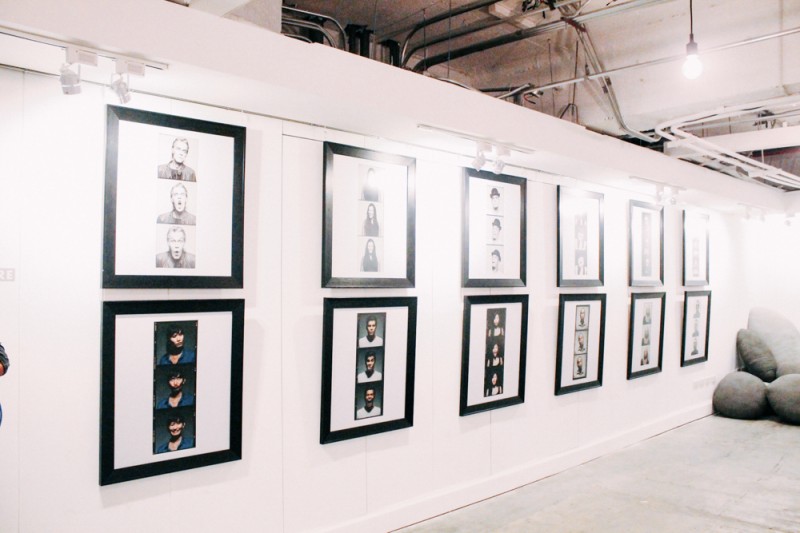
The gallery at A SPACE. Photo courtesy of A SPACE.
For Viva Manila’s co-founder Julia NEBRIJA, it is the people that make the spaces. She says, “Creatives particularly are valuable because they see opportunities in a way others don’t. Especially as it relates to cities and urban spaces, artists and other creatives can facilitate experiences that showcase new possibilities, whether that’s activating an abandoned space with an installation, performing in a public area, or making a street market - these are alternative ways to interact with the city which people might not have imagined previously.”
Roldan of Green Papaya Art Projects adds that commitment and relevance are big factors in sustainability. ”You need to make your goals relevant. No matter how much money you put into a space, if there’s no community to serve or engage with, money becomes immaterial.”
The ‘chicken-and-egg’ paradox
Artistic production in the Philippines has always been thriving and this need for expression can easily be found in pockets of creativity scattered all over the metro. Do these spaces make up the city, or does the makeup of the city induce these spaces? Do these spaces shape the city, or does the city shape these spaces? Such are the ebbs and flows of Metro Manila’s creative spaces, as the city struggles to breathe and live, and give inspiration to its 20 million and rising inhabitants.
Lai del ROSARIO is an art manager and freelance writer with a keen interest in European-Asian artistic collaborations, having lived and worked in Switzerland, France, and the Philippines. She is also currently developing an online platform that promotes creative spaces in cities.
Further reading
http://www.philstar.com/business/2014/11/30/1397319/creative-industry-contributed-p661b-phl-economy-2010
http://www.unesco.org/culture/creativecities/
http://www.ces.uc.pt/cesfct/nd/DuxburyMurray2009-CreativeSpaces-Sage.pdf
http://artradarjournal.com/2010/07/14/clarissa-chikiamco-on-philippine-independent-art-spaces-funding-challenge-phillippine-star/

